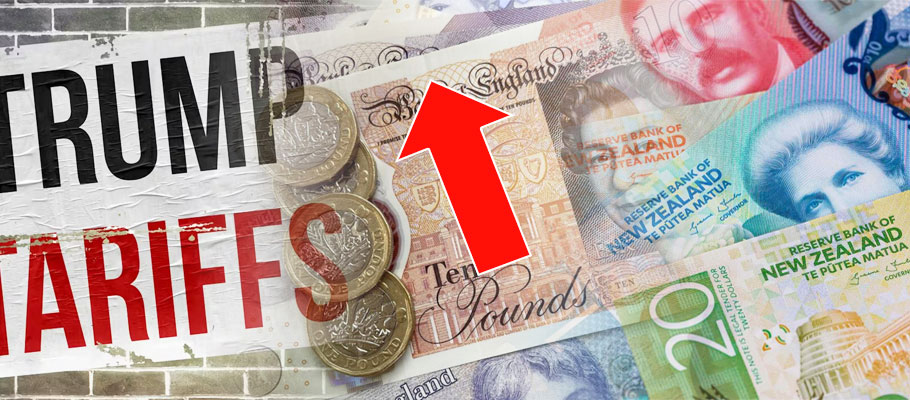
Published: February 5th, 2025
The British Pound to New Zealand Dollar rate (GBP/NZD) broke north of its 21-day exponential moving average last week (wc 27 January 2025), beginning a brief uptrend that analysts say could be sustained through this week’s session and possibly beyond.
The pair got a boost on Monday, rising to 2.2156 on news that the White House had made good on its tariff threats against Mexico, China, and Canada over the weekend.
Investors worry the tariffs will hinder growth and reduce global trade as the new month begins. As a commodities-dependent currency, the Kiwi is sensitive to shifts in broader sentiment. If tariff concerns weigh heavily, GBP/NZD could trend higher.
A research note from Commonwealth Bank of Australia said AUD/USD and NZD/USD had both dipped by about two per cent in the aftermath of President Trump's newly declared trade battle.
‘Both antipodean currencies are normally sensitive to trends that undermine global trade and downbeat shifts in trader risk appetite.’
From another perspective, Commonwealth analysts say GBP/USD is showing resilience in the face of tariff threats, helped along by the UK’s trade deficit with the US. A strong showing in GBP/USD rates and weakness in NZD/USD would likely translate into gains for GBP/NZD.
With a 0.70 per cent leap forward on Monday, GBP/NZD made a notable gain. Commonwealth analysts expect some of it to be consolidated as the week unfolds.
‘As the Trump administration pursues its punitive tariff agenda we expect more countries will find themselves in the crosshairs, not least those in the Eurozone.’
An analysis by Sydney-based Westpac in October 2024 had the New Zealand Dollar set for gains against most G10 majors by the middle of 2025.
An improving international growth backdrop and a US Dollar set to trend lower would benefit the Kiwi, Westpac analysts said, adding that forex traders should also watch for an uptick in New Zealand’s economic growth as the Reserve Bank of New Zealand's (RBNZ) then policy of restrictive interest rates could loosen in the coming months.
'Auckland central bankers started the RBNZ’s easing cycle ahead of some G10 peers and seem intent on moderating that approach ahead of what traders had expected. There has been a notable loosening of financial conditions as retail and wholesale interest rates have moved to levels not seen in years,’ Westpac wrote.
Despite past signals to the contrary, the RBNZ was thought to be comfortable with relaxing interest rates on an accelerated timeline. 'As headline CPI inflation is predicted to stay around the mid-point of policymakers’ 1-3 per cent target range during the third quarter, the RBNZ sees an environment where they have more freedom to respond to weakening economic indicators.’
Financial conditions in New Zealand had eased notably in September, with short-term swap rates falling to around 100 basis points, while mortgage rates have dropped by 50-100 basis points.
Westpac analysts believed the RBNZ would announce two 25 basis point cuts in its two remaining 2024 meetings, which did occur.
In March 2024, analysts at two of The Netherlands’ largest banks said the Kiwi was on track to be one of this year’s outperformers, despite a previous string of losses.
NZD lost ground against other majors in February after Auckland central bankers held the official interest rate at 5.50%, disappointing some forex traders who were counting on another near-term rate hike. Guidance from the Reserve Bank of New Zealand’s (RBNZ) February meeting prompted a selloff and reappraisal of New Zealand interest rate prospects, with bets firming up for a new round of cuts in the Autumn.
In a note to investors, ING Bank’s FX Strategy Unit wrote that the RNBZ’s statement was ‘less hawkish than expected given that another rate hike looks to be off the table for the foreseeable future. The immediate result has been losses for the New Zealand dollar.’
But ING added that traders ‘shouldn't buy into perceptions of NZD weakness. Over at fellow Dutch banking giant ABN AMRO, currency analysts are in broad agreement. A market analysis published this week says the New Zealand dollar 'is still on track to outperform’ in 2024.
The New Zealand Dollar fell when the RBNZ cut its own official interest rate forecasts from 5.69 per cent in November 2023 to 5.60 per cent in February 2024, reducing the implied probability of a rate rise to below 40 per cent.
A statement from the central bank after its scheduled February meeting used softer language to describe the likelihood of additional tightening, prompting traders to price-in 2024's first rate cut for September.
At the end of November 2023, the New Zealand Dollar was the best-performing major currency thanks to positive global market conditions, new measures by China to kick-start the country’s slumbering economy, and a recent print of upbeat retail sales figures.
A market analysis from Crédit Agricole’s Currency Strategy Unit said rising New Zealand retail sales had made the Kiwi the G10’s top performing currency for the month of November.
Figures from Stats NZ showed that Q3 2023 retail sales volumes hit zero per cent quarter-on-quarter, much higher than the negative -0.8 per cent consensus was looking for and sharply up from Q2's negative -0.9 per cent.
The numbers provided some hope that the GDP print due for publication on 14th December would come in above expectations, likely giving NZD another boost.
But the bank also pointed to global drivers as key to the Kiwi's upward momentum, given that November was also shaping up to be the best month of the year for global stock markets.
Upbeat investor sentiment tends to be supportive of the New Zealand Dollar and helped it advance against all G10 peers in late 2023 except the Swedish Krona.